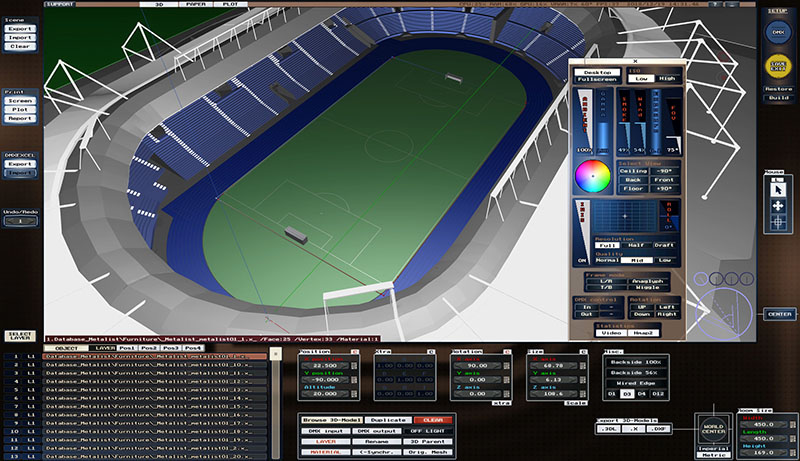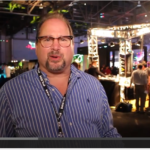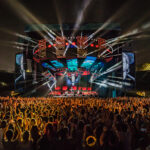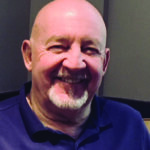Kiev-Based Innovators Keep Redefining the State of the Previz Art

There are several companies that offer previz software, but one product, LightConverse 3D Show Platform, has been at the forefront. Along with the testimony to the product’s worldwide popularity and success through sheer longevity — the latest release is Version 59 — industry honors includes ESTA and Live Design awards as well as the privilege of being an Intel Software Premier Elite Partner since 2012.
In July 2018, the software development team behind their LightConverse 3D Show Platform became full owners of the software products they had been developing, forming a new company and moving to a new office in Kiev, Ukraine in the process. A new company, L8 LLC (L8.ltd), was created to rebrand LightConverse and drive the product forward to create a new path forward for its user base, working to further develop, distribute and create new avenues and evolutions for the product.
“We started L8 LLC with a strong vision of what we should do, how we should create, and how we should support our product and our users,” says Dmitriy Giventar, the creator of the original LightConverse, who now jointly owns the company with the other developers. “We have a very highly motivated team of seven premier professionals, located in a great place atop the Scientific Center of Kiev, near the Kiev Polytechnic Institute.”

Meeting Evolving Industry Needs
Our industry has changed over the years in many ways that complicate the way lighting design and pre-production occur. Beyond the obvious designer and programmer time needed are the not-so-obvious evolutions of venue costs; the time associated with spending days or weeks in a venue sharpening cues, timings, and tuning looks, all of which cost exponentially more. That extra cost has decreased the available time that designers get to spend in the venue or in tour rehearsals, and alongside that increase and cost and decrease in time, the pressure on design teams has increased. These are all reasons that make previsualization software a common necessity in the design of shows these days.
L8 recreates the venue in virtual reality, in as much detail as is technologically possible, all while mirroring the physics of the real world as closely as possible, all the way down to the way that the atmospherics behave when the HVAC is running and the audience has changed the level of humidity in the air.

A myriad of details are needed to be taken into account for the world of previsualization that most other programs doesn’t consider— such as how lasers behave in the air, for example. Or who can accurately portray a dimmed beam, or a beam utilizing a multi-color gobo? How do we show the actual motor speeds of a glass color wheel inside of a fixture moving on a piece of scenery that is also moving? How do we recreate the actual look and feel of lighting, scenery, textures, video, atmospherics, and other variables, as photo-realistic as possible, all while not overwhelming the average currently available technology that 80 percent of the industry can afford? These are the challenges that L8 worked to achieve and separates it from the others.
L8 has created a virtual world that gives its users the ability to place themselves directly inside a world with physics mirroring reality. Along with meeting the requirements of a stable virtual environment that allows you to cue, render, connect, and track moving set pieces or performers, L8 also gives users something invaluable: the ability to test new equipment, new technologies, and new fixtures in their designs without having to fork out thousands of dollars in rentals, both on the equipment side and on the venue side to see if certain fixtures may be the right choice for a particular event.

These days most pyrotechnics are run from DMX controlled lighting consoles. On some events the LD triggers them along with his light cues, though most productions choose to operate said effects from a separate console, with a separate operator. For a long time, the issue with getting pyro cues perfected required hours of practice and experimentation with various types of effects ranging from gerb waterfalls to tracing comets, propane flames to actual water effects. To constantly reload the effects and rehearse takes hours and costs thousands of dollars in product while the designers work to program the desired effect. With L8, the designer can simulate all sorts of effects to gauge the cue timing as well as amount of product needed for the desired effect.
In the last few years the live event business has seen some cutting edge technology using water in live performances. L8 is able to recreate falling water and fountain effects. Drones have also become more commonplace and integrated into some high profile events. Using drones efficiently in the L8 software was achieved wonderfully. They can even make confetti rain on the crowd in real time. The idea of being able to show a potential client what you can offer them through a visual presentation, as opposed to just explaining the idea on paper, can only be described as a great tool for designers to obtain choice gigs.

A Lengthy (and Changing) Road
The road to a usable digital environment in which the realistic world can be even somewhat replicated has been long and changing, dictated not just by evolving industry needs but also by the availability of computing technologies and software development tools. Giventar notes how, before rising to the challenge of previz, he began his work in the lighting industry with a program called RoboShop, which was born out of DOS and by sending DMX-512 over a computer’s LPT port (the parallel port) with a LPT to DMX cable.
“After graduating my University program as an engineer, I was very excited with the lighting industry, and wanted to continue my work in the lighting business,” Giventar says. “Digital standards like DMX came into our lives, and it was an interesting process to work on software that controlled lighting at that time. I created a software suite called RoboShop Digital back in April of 1997, which used signal directly from the LPT port with the help of a simple parallel to XLR adaptor. This was my first foray into the world of lighting control software.”
No pun intended, a universe of technological development has occurred since the days of DOS and LPT ports, and in that time, the skeleton of today’s LightConverse was born.
“RoboShop was very popular in our community, and we received enough positive feedback for that program that I decided to continue developing for the lighting industry,” Giventar says. “Due to the success of RoboShop, I met a group of people that were interested in collaborating on new products that I was producing, and in 1998 we began the journey of working together on what would ultimately become LightConverse.”
Giventar then embarked on a new journey: from the DOS-based RoboShop lighting control software, a new software direction was created that focused on what lighting designers collectively needed — a software suite that allowed for lighting control and visualizing the lighting design digitally. After several years of development, the new LightConverse software was introduced, first at the 2003 Ukrainian Music Fair in Kiev, and then in Frankfurt, Germany at Musikmesse/Pro Light+Sound 2004.
“When we first released LightConverse to the lighting industry, the main difference between our product and other industry products at the time was the photorealistic quality of 3D visualization,” Giventar says. “Computer hardware at the time was a challenge, because the software we were all developing was more advanced than the available hardware at the time. We chose two main goals, which were quality and speed, and that decision has been the key to success for LightConverse.
“We looked directly into gaming technology of the time to achieve those goals, and in that industry subset, Microsoft’s DirectX technology was increasingly popular,” Giventar continues. “Also at the time, a competitor called OpenGL technology was gaining popularity, but it did not develop as quickly and was utilized mainly for applications like CAD, so we were at the junction of two avenues of computing, computer games and lighting. Our decisions at that time have been the backbone of successful development of the LightConverse product.”
Listening to the Users
L8 (LightConverse) has been at the forefront of lighting previsualization for almost 15 years now, and some of the technological advances in computing have influenced the way that L8 has helped shape the previsualization subset of the lighting industry as a whole. But this development goes both ways, which has made the software popular among its user base. The users of L8 have helped to shape the way that the software has developed through production utilization and creative ideas from lighting designers. As the lighting design world develops, LightConverse has kept steadily developing along side to not only keep their user base satisfied, but to help that user base develop as well. “L8 is a product that allows you to see and develop your lighting design ideas,” says Giventar. “We ask ourselves the question, ‘How do we continue to develop and shape the lighting industry’s creativity’ as a matter of purpose.”
As a dedicated developer of previsualization software, Dmitriy Giventar is also a passionate believer in helping the industry grow. “On one side of the equation, L8 is a tool for professionals, to help shape and develop their lighting design ideas, and share them,” Giventar promotes. “But on the other side, it is a major part of the creation process. L8 is an environment where ideas are born and nurtured. It doesn’t matter what you want to do, and it doesn’t matter if it’s been done before or not — we develop our software so that people from all skill levels of the industry can create their best work. Our users’ ideas are the significant driver for us to make the best product we can, from inception to realization. The way that L8 works best is when it is used by people who enjoy what they do.”
Latest Software Features
In addition to some of the features you would expect the program to have perfected, like an advanced GUI and high-quality 3D resolution, L8 has added quite the digital toolkit to their software suite, the most current version being Version 59. Built-in Light Meter calculations adorn the program, with center-weighted lux measurements on surfaces, and the generation of lux maps with automatic legends generated in the Paper Mode, which lead to the creation of high-quality lighting paperwork. L8 has extended color dynamics and luminance-corrected gamma settings, among other HDR-centric operations that help make the 3D view as accurate as possible while not making the program cumbersome to your computer hardware.
With respect to the GUI, L8 allows the user four distinct camera presets on the main GUI screen, giving you quick access to separate camera views with control of exposure, color, intensity, and camera iris. L8 also provides a precise mode for viewing wide camera angles, called Equidistant Mode, giving one beautiful views of the long shots without compromising on quality. Screenshot and video capture action buttons and settings are all available from the GUI itself, which makes manipulation of the program simple and not a burden — you can maneuver in and out of your design while not being bogged down by a cumbersome user interface.
L8 produces very high quality screenshots and screen captures of the lighting environment, with incoming DMX, video sources, and other media. Renderings are high quality, both stills and as MP4 video. The software includes an onboard camera that can be controlled via DMX, giving you fly through ability of your design work. In addition to high quality 3D rendering, L8 is compatible with virtual reality software to break a hole in the proverbial fourth wall — users of Oculus Rift and HTC Vive can step inside the design environment and truly live inside the world of L8. The feature has been in use since 2013, with the Oculus DK 1 and DK2.
The program allows you to map high-resolution video onto surfaces in the virtual environment. One of the more impressive technologically detailed features of the software is its use of raytracing technology in real time. “The classic rendering pipeline is based on primitive shapes that are simply rasterized,” Giventar states. “What L8 does differently is in the approach to how we define raytracing — we take pixels from the screen and push them to their depth, and calculate the collision of a ray with a surface, and whether it reflects or not. Simplifying that, we’re able to calculate the amount of lighting energy a pixel received from the environment, in real time. This was previously very difficult to do effectively without overloading average existing hardware.”
L8 has been using raytracing technology since the beginning of 2018 with L8 releasing V59 back in January. “Look at the visualization of light beams and projections in L8, and you will see no compromises,” says Giventar. “Our beams are true to real life, and because of the raytracing technology, you see accurate representations of your designs. The zoom, and even focus and frost are visualized correctly.”
Looking Ahead
Building upon its preeminent software and guided by new company owners who have been immersed in the product’s development, Giventar is looking forward to the continuing challenge of serving the live event production industry as it continues to evolve and change. “The future of LightConverse is very bright, and we all look forward to continued development and growth for the worldwide LightConverse user base and for the production industry together.”
For more information, and to download the latest version of L8, go to www.L8.ltd.
NOTE: Since this article has been printed and posted, Vladimir Berenok, director of Ukraine-based company, Light Converse Ltd., has contacted PLSN to let us know that Light Converse Ltd. is still operating, with the website www.lightconverse.ua. So while the headline, “From LightConverse to L8,” reflects Dimitriy Giventar’s creation of a new previz software company, L8 LLC, readers should understand that the original company behind LightConverse 3D Show Platform, where both Berenok and Giventar worked, has not itself rebranded as L8.



